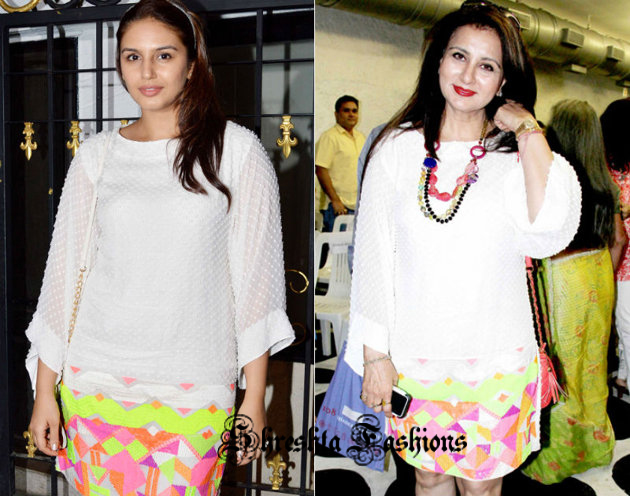Tuesday, June 25, 2013
Netted Designer Lehanga/Langa for 5 year girl
Wine and gold shaded Net langa/lehanga with mango motifs thread embroidery all over the body and Bronze colored 3-4" sequins border .
Blouse is of Panel/Princess cut with sequins fabric on the side panels whereas the centre panel isa plain fabric of semi raw silk.Puff sleeves with lehenga fabric and thin sequins border is been attached.
Sunday, June 23, 2013
PHULKARI - the traditional embroidery from the Balle Balle region

Phulkarian embroidery technique is from the Punjab region with respect to both India and Pakistan .Phulkaria means flower working i.e., in depth the word 'Phul' means flower and kari means craft.At one time it was used as the word for embroidery, but in time the word “Phulkari” became restricted to embroidered shawls and head scarfs. Simple and sparsely embroidered odini (head scarfs), dupatta and shawls, made for everyday use, are called Phulkari's, whereas garments that cover the entire body, made for special and ceremonial occasions, are known as Bagh's which means "garden".
Phulkari's and Bagh's were worn by women all over Punjab during marriage festivals and other joyous occasions. They were embroidered by the women for their own use and use of other family members and were not for sale in the market. Thus, it was purely a domestic art which not only satisfied their inner urge for creation but brought colour into day to day life. In a way, it was true folk art. Custom had grown to give Phulkari's and Bagh's to brides at the time of marriages. Some best Phulkari's and Bagh's are known to have been made in Hazara and Chakwal, areas of Northern Punjab in Pakistan.
Some scholars feel that the art of Phulkari came from Iran where it is known as “Gulkari”. Some feel it came from Central Asia along with Jat tribes who migrated to India and settled in Punjab,Haryana and Gujarat. There is reference of Phulkari in Vedas, Mahabharat, Guru Granth Sahib and folk songs of Punjab. In its present form, Phulkari embroidery has been popular since the 15th century.
The main characteristics of Phulkari embroidery are use of darn stitch on the wrong side of coarse cotton cloth with coloured silken thread. Punjabi women created innumerable alluring and interesting designs and patterns by their skillful manipulation of the darn stitch. The base khaddar cloth used in Western Punjab is finer from those of Central Punjab. In West Punjab, 2 or 3 pieces of cloth are first folded and joined together. In East Punjab, they are joined together first and then embroidered.
In Phulkari embroidery ornaments the cloth, whereas in Bagh, it entirely covers the garment so that the base cloth is not visible. The end portion of pallav of Phulkari have separate panels of exquisite workmanship of striking design.The most favoured colour is red and its shades, because Bagh and Phulkari are used during marriage and other festivals. Red is considered auspicious by Hindus and Sikhs. White was used in Bagh by elderly ladies. Silk thread in strands came from Kashmir, Afghanistan and Bengal. The best quality silk come from China.
No religious subject or darbar scenes were embroidered. Phulkari encompassed life in the villages. Creative ability of Punjabi women has produced innumerable and intricate geometrical patterns. However, most motifs were taken from everyday life. Wheat and barley stalk with ears are a common motif.
Traditionally, phulkari garments were part of a girl's wedding trousseau, its motifs expressive of her emotions and the number of phulkari pieces defined the status of the family.Over the years, government has been working towards promotion of phulkari embroidery, by organizing special training programs, fairs, and exhibitions.Since most of women artisan creating phulkari are in the unorganized sector or work through agents, they do not make much money compared to an actual market price of their product.
Now a days some modern fashion designers are incorporating this embroidery into their garments, and its use has spread beyond salwar kameez and dupatta to objects and garments as varied, as jackets, bags, cushion covers, table-mats, shoes, slipper, juttis, and kids garments.In 2011, Phulkari was awarded the geographical indication (GI) status in India.
Tuesday, June 18, 2013
Bollywood Beauties with and without Make-up
Everybody Knows that mostly people follow the fashion of Bollywood and of course Tinsel town too..Some do even go mad about their Beauty,make-up,hair styles etc.,Sometimes we do wonder how our pretty ladies might look without make up.....So, guys this is for those who wants to see a sneak peak into our beautiful ladies of Bollywood with and without make up...
Just an addition from Hollywood -Sharon Stone :)
Thursday, June 13, 2013
SAME PINCH - Stars Wearing Similar Dresses
Wednesday, June 5, 2013
Subscribe to:
Comments (Atom)












































